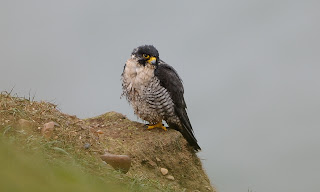This was my best effort, digiscoping in a bitterly cold northerly with my eyes streaming taken at 100 yards distance, so all in all I am quite pleased with the effort. This was one of twelve birds on site, far exceeding my previous best of four birds
I hope you enjoy your visit, please leave comments on the pictures you like. phillip.hasell@ntlworld.com
Monday, 16 April 2012
Thursday, 12 April 2012
Tree sparrows
The tree sparrow is now a bird in decline in the south of England so it is always a delight to see them when we visit the northerly counties, these were around the visitor station at Bempton cliffs.
Peregrine falcon
Our fastest raptor did not look at its best all scrunched up in the rain, but we had superb views through our binoculars
Puffins and Fulmars
A small selection of the birds we saw at Bempton, the puffins on their ledges were too distant for photography but some obliged with fly pasts. the fulmars were patrolling the updrafts along the cliff face effortlessly.
Guillemots and kittiwakes
The first two birds show the variations we get in British waters of the guillemot, the bird on the right is of the 'bridled' morphism, picture two is a guillemot in flight and picture three a kittiwake and a guillemot sharing a ledge, picture four shows typical kittiwake nests, some even nest on the sides of buildings in some cities, picture five is the elegant kittiwake in flight, these birds spend large periods of the year far out at sea.
Razorbills
Razorbills always appear to be really smart snappy dressers, either in flight or standing on their ledges, I had never before come across a double headed one as in the last picture!
Masters of the wind
Is there a finer British seabird - not for me, these magnificent birds use the wind so effectively that flapping is not something they need to do a lot of. The final picture was all I could fit in with my 300mm lens. Les and I are planning to go back up to Yorkshire later in the year and go out on the boat to the cliff bottom to get among the birds for a different experience.
Gannets
Les & I went up to Bempton Cliffs RSPB site for the first time in about 15 years and the gannet colony has increased in size tenfold in that time to circa 10,000 pairs and at this time of year they are busy nest building and parading along the cliffs giving anyone with a decent camera the chance of some spectacular pictures. In the eight hours we spent there I took about 850 pictures which I slowly waded through to finish up with eight that I thought gave a fair representation of what we saw. The bird in the top picture almost fell off the ledge in its attempt to reach down for some nesting material, others were landing on the cliff top and pulling up grass to use (picture 3). Others had done the traditional job of bringing back seaweed and old pieces of fishermens rope for theirs. Picture two is a bit of pair bonding after one returns from a trip out fishing and is often the precurser to mating. The last picture is of a sub adult which might well be an adult by next year.
Subscribe to:
Posts (Atom)




























